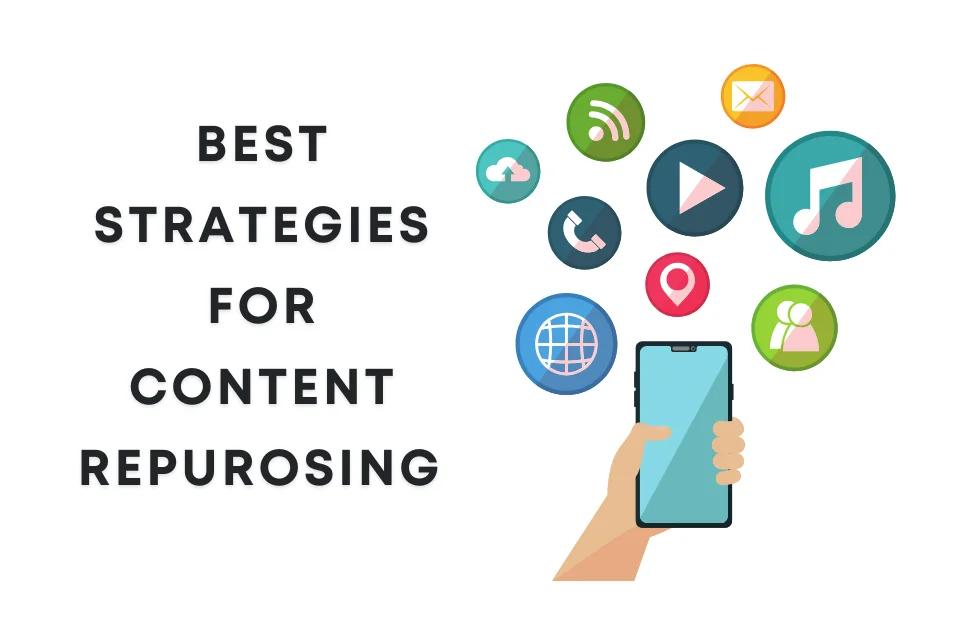Table of contents
- How to Maximize Your Content’s Lifespan
- What is Content Repurposing?
- Why Content Repurposing is Essential
- How to Identify Content Worth Repurposing?
- Best Ways or Strategies to Repurpose Content
- Tools to Help in Content Repurposing
- Tips for Effective Content Repurposing
- Common Mistakes to Avoid
- Best Examples of Content Repurposing
- Conclusion
Content Repurposing: How to Maximize Your Content’s Lifespan
Did you know that 60% of marketers create at least one piece of content every day, yet only 42% feel their content is effective?
With the fast pace of today’s digital age, producing new content on a regular basis can seem like climbing a mountain. But what if I told you that you could get more mileage out of the content you’ve already produced? Now that’s where content repurposing comes in.
Content repurposing is the process of taking existing content and adapting it for different formats, platforms, or audiences. It’s not just a time-saver—it’s a strategy to maximize your content’s lifespan, reach new audiences, and boost your ROI.
In this blog, we’ll explore why content repurposing is vital, the best strategies to implement, useful tools, and expert tips to ensure you get the most out of your content.
What is Content Repurposing?
For example:
- Turning a blog post into a video or infographic.
- Breaking down a webinar into social media snippets or a podcast.
- Republishing old eBooks by simply updating it with new data.
The aim of content repurposing is to maximize the value of your content by making it reachable and interesting for different audience segments or platforms.
Why Content Repurposing is Essential

1. Boosts SEO and Online Visibility
Search engines like Google always favor fresh content. By repurposing, content you can keep your website updated, improve rankings and attract organic traffic. Republishing old content with new keywords creates more chances to rank for relevant keywords.
2. Reaches a Wider Audience
Not everyone consumes content in the same way. Some prefer reading blogs, while others engage better with videos, infographics or podcasts. The repurposing ensures your message reaches diverse audience segments across multiple platforms.
3. Saves Time and Effort
Creating new content from scratch can be tiring. Repurposing allows you to build on what you already have, this save time and effort while delivering value to your audience.
4. Increases Brand Authority and Engagement
Consistent messaging across different channels establishes credibility and strengthens brand recognition. The more people see and interact with your content, the stronger your industry authority will be.
5. Maximizes ROI
How to Identify Content Worth Repurposing?
1. High-Performing Content
Look at your analytics to find content that has already performed well. This could be a blog post with high traffic, a video with loads of views, or even a social media post with strong engagement.
2. Evergreen Content
Evergreen content—topics that remain relevant over time—is perfect choice for repurposing. Content like “how-to” guides, FAQs, or industry insights will be best option for repurposing.
3. Content with Potential
Some content may not have performed well initially but has strong ideas or data. With a little tweaking, it could perform well and become a winner.
4. Audience Feedback
Best Ways or Strategies to Repurpose Content

1. Turn Blog Posts into Social Media Content
Your long-form blog posts contain valuable insights that can be repurposed into bite-sized content for social media. Here’s how:
- Create LinkedIn Carousels: Break down blog highlights into a visually engaging slide deck.
- Transform Key Points into Twitter Threads: Share insights in a step-by-step format.
- Make Instagram Posts & Stories: Design visually appealing graphics using key statistics and quotes.
- Share Short Videos: Use Reels or TikTok to summarize blog points in an engaging manner.
2. Convert Blog Posts into Videos & Podcasts
Many users prefer audio and video content over reading long blogs. Repurpose your written content into engaging multimedia formats:
- YouTube Videos: Convert blog content into informative video explainers.
- Live Webinars & Q&A Sessions: Use blog content as the basis for interactive discussions.
- Podcasts: Read and elaborate on blog topics to create valuable podcast episodes.
3. Transform Data into Infographics & Presentations
Visual content is more shareable and easier to digest. Convert long articles or reports into visually engaging formats:
- Infographics: Summarize blog information into an eye-catching infographic.
- Slides & Presentations: Turn content into PowerPoint presentations and share on platforms like SlideShare.
4. Create an E-book or Whitepaper
If you’ve written multiple blogs on a related topic, consider compiling them into an in-depth resource:
- E-books: Group related blogs together to create a comprehensive guide.
- Whitepapers: Provide detailed insights and case studies for industry professionals.
- Lead Magnets: Offer e-books or whitepapers as downloadable resources to grow your email list.
5. Repurpose into Email Newsletters
Email marketing remains a powerful tool. Instead of writing fresh emails, repurpose blog content:
- Summarize Key Insights: Provide blog highlights in a concise email.
- Link Back to Your Website: Encourage readers to visit your blog for full details.
- Exclusive Tips & Updates: Add value by including additional insights not covered in the original blog.
6. Refresh and Update Old Content
Instead of creating new content, breathe life into existing content by:
- Updating Outdated Information: Add recent statistics, trends, or insights.
- Enhancing SEO: Optimize with new keywords and internal linking.
- Republishing on Different Platforms: Share on Medium, LinkedIn Articles, or Quora to reach a wider audience.
Tools to Help in Content Repurposing

1. Design Tools
- Canva: Create stunning visuals and infographics.
- Adobe Spark: Design social media graphics and videos.
2. Video Tools
- Lumen5: Turn blog posts into engaging videos.
- Animoto: Create professional videos quickly.
3. Audio Tools
- Audacity: Edit and produce podcasts.
- Descript: Transcribe and edit audio content.
4. Content Management
- Trelloor Asana: Organize your repurposing workflow.
5. SEO Tools
- SEMrushor Ahrefs: Optimize repurposed content for search engines.
Tips for Effective Content Repurposing
1. Tailor Content for Each Platform
Not all content formats work well on every platform. Adjust tone, structure, and style to suit the platform’s audience. For example, Instagram thrives on visuals, whereas LinkedIn prefers professional insights.
2. Optimize for SEO
While repurposing content, integrate relevant keywords, update metadata, and ensure internal linking to boost search rankings.
3. Keep Branding Consistent
Use the same brand colors, fonts, and messaging to maintain a cohesive brand identity across different platforms.
4. Monitor Performance & Adjust Strategy
Track engagement metrics, traffic, and conversions to understand what content performs best and refine your repurposing strategy accordingly.
5. Don’t Overdo It
Repurposing is about enhancing content longevity, not spamming audiences with repetitive information. Ensure each format adds unique value.
Common Mistakes to Avoid

- Repurposing Low-Quality Content: Avoid reusing content that didn’t perform well unless you plan to improve it.
- Ignoring Audience Preferences: You should not repurpose content without considering what your audience wants.
- Overloading the Same Audience: Be mindful of not bombarding your audience with the same content in different formats.
- Neglecting SEO: Neglecting SEO can be harmful for business, it is important to ensure repurposed content is optimized for search engines.
Best Examples of Content Repurposing
One of the most known social media entrepreneur and content creator of India “Ranveer Allahbadia” also known as “BeerBiceps”, excels the art of content repurposing and use the content across platforms like YouTube, Instagram, LinkedIn, and X (formerly Twitter), focusing on personal development, entrepreneurship, and wellness. Here’s how he does it:
Ranveer’s Content Repurposing Strategies
1. Cross-Platform Sharing
He shares content across multiple platforms. For example, a motivational YouTube video is broken into clips or quotes for Instagram and X.
2. Content Transformation
Long-form content, like his podcast The Ranveer Show, is turned into shorter formats such as Instagram Reels, X posts, or LinkedIn articles.
3. Educational Content
Through BeerBiceps Skillhouse, he repurposes his podcasting expertise into structured courses, offering value in a new format.
Example: Repurposing The Ranveer Show

Repurposed Content
- Instagram: Short clips with key takeaways or quotes.
- X: Bite-sized quotes or key points to spark discussions.
- YouTube Shorts: Compelling segments or episode summaries.
Why It Worked for Him
- Reach: With over 2.3 billion podcast views, repurposing helps him tap into new audiences.
- Engagement: High engagement rates on LinkedIn (97.9/100) and Instagram (97.7/100) ensure his content resonates.
- Diversification: By adapting content for different platforms, he caters to varied audience preferences.
Conclusion
To conclude this blog we can say that content repurposing isn’t just a hack – it can be a game-changing strategy for marketers and businesses looking to maximize their content’s lifespan.
By identifying high-performing content and changing into different formats by using right tools and techniques, one can easily create a solid stream of valuable content without starting from scratch.
Now that you understand the power of content repurposing, it’s best time to take action! Start by choosing one of your best-performing blog posts and repurpose it into different formats.
By implementing the techniques above, you’ll make sure that your content works smarter, not harder, and continues to generate value long after its initial publication.
So, what’s the first piece of content you’ll repurpose? We will leave it you!

